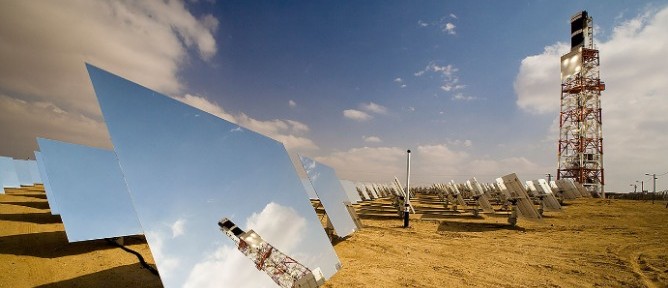BrightSource´s main push now is the Ashalim Concentrated Solar Power (CSP) plnt in Israel’s Negev desert. The 121 MW solar thermal plant is scheduled to be complete in 2017.
BrightSource Energy’s massive Ivanpah project in the Mojave Desert was supposed to be its first solar thermal power plant in California. At least three other solar thermal power plants were envisioned in Southern California: Rio Mesa in Riverside, Hidden Hills in Inyo County, and Palen, also in Riverside.
But getting large, land-intensive projects built in the Golden State is easier said than done and, project by project, failed to come to fruition. Late Friday, BrightSource and its partner, Abengoa Solar, withdrew their application for Palen with the California Energy Commission — effectively ending BrightSource’s pipeline of California projects.
Palen had come under fire from advocates of Joshua Tree National Park, Native American groups and biologists concerned about the potential for bird deaths from intense radiation from the thousands of mirrors, known as heliostats. And Palen was unlikely to be completed by December 2016, putting its ability to qualify for the 30 percent investment tax credit that expires at the end of that year in jeopardy.
So what’s next for Oakland-based BrightSource?
“We’re focusing increasingly on markets for solar thermal on a global basis,” said Joseph Desmond, BrightSource’s senior vice president of marketing and government affairs, in an interview. “There’s strong interest in Morocco and the Middle East, and South Africa is an excellent market.”
Unlike the photovoltaic solar panels that are increasingly common on the roofs of homes and commercial buildings, solar thermal technology concentrates the sun’s rays to boil water and generate steam. Solar thermal, also known as concentrating solar power, or CSP, is land-intensive, requires access to transmission lines and typically faces several environmental reviews and permitting hurdles before projects can be built.
BrightSource’s Ivanpah project faced several concerns about its impact on the desert tortoise, but now that the project is online, the impact on birds — which have flown into the heliostats or been singed from the radiation — has become an even bigger issue; The Wall Street Journal recently called Ivanpah a “$2.2 billion bird fryer.” Several members of the public mentioned birds in comments to the California Energy Commission about Palen.
California’s investor-owned utilities are under pressure to meet the state’s 33 percent renewable mandate, which requires utilities like PG&E and Southern California Edison to get 33 percent of their electricity from renewable sources like wind and solar. But as more solar comes onto the grid, utilities and grid operators want large solar thermal power plants to come with storage technology, so that the solar can be effectively saved. BrightSource and Abengoa had said that Palen would be able to phase in storage.
Southern California Edison has identified several factors as challenges to achieving California’s renewable energy goals. Chief among them: the permitting, siting, approval and construction process of both transmission and renewable generation projects.
“We believe concentrating solar power, and specifically tower technology with thermal energy storage, can play a key role in helping California achieve its clean energy goals by providing the necessary flexibility needed to help maintain grid reliability,” said BrightSource in a statement about the withdraw of Palen. “In addition, we are committed to bringing projects to the market that follow sound and responsible environmental measures to ensure all impacts are avoided, minimized or compensated for properly.”
http://www.helioscsp.com/noticia.php?id_not=2715
termosolar, Concentrated Solar Power, Concentrating Solar Power, CSP, Concentrated Solar Thermal Power, avian, solar power, israel, solar energy, BrightSource Energy,



